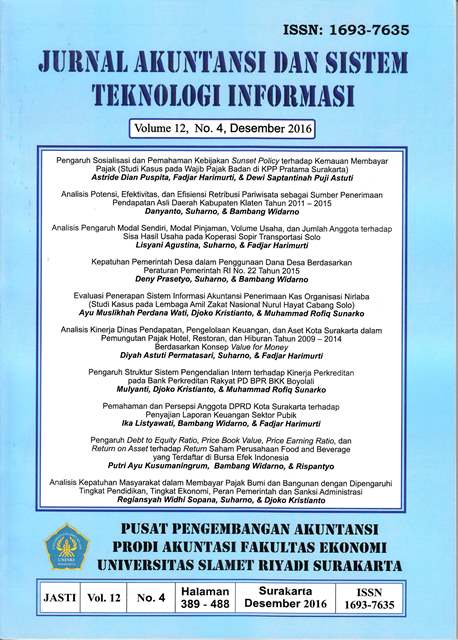ANALISIS KINERJA DINAS PENDAPATAN, PENGELOLAAN KEUANGAN, DAN ASET KOTA SURAKARTA DALAM PEMUNGUTAN PAJAK HOTEL, RESTORAN, DAN HIBURAN TAHUN 2009 – 2014 BERDASARKAN KONSEP VALUE FOR MONEY
Abstract
The purpose of this study is to analyze the financial performance of the Department of Revenue, Finance and Asset Management Surakarta perspective in terms of economy, efficiency and effectiveness of tax revenue the hotel, restaurant and entertainment by using the concept of Value For Money. This study uses secondary data with quantitative data analysis techniques based on the ratio of economy, efficiency and effectiveness and qualitative data that is on the Department of Revenue, Finance and Asset Management Surakarta. The results of the analysis based on the assessment criteria which refers to the Decree of the Minister of Interior number 690900-327 on Financial Performance Assessment guidelines, showing the performance of the Department of Revenue, Finance and Asset Management Surakarta Value For Money Concepts based on tax receipts hotels, restaurants and entertainment year average 2009 –2014 can be categorized as very economical, very efficient, and very effective. Efforts - the efforts made by the Department of Finance and Asset Management Revenue Surakarta is intensifying outreach Increase taxation to the taxpayer in order to understand even aware of the importance of Taxes Hotel, Restaurant and Leisure as one component of the Local Taxes are used to finance regional development.
Keywords: Revenue, PAD, value for money, economy, efficiency, effectiveness
Downloads
Published
Issue
Section
License
Authors who publish this journal agree to the following terms:
- Authors retain copyright and grant the journal right of first publication with the work simultaneously licensed under a Creative Commons Attribution License that allows others to share the work with an acknowledgement of the work's authorship and initial publication in this journal.
- Authors can separately make additional contractual arrangements for non-exclusive distribution published by the journal (e.g., publish it in a book), with an acknowledgement of its initial publication in this journal.
- Authors are allowed and encouraged to send their work via online (e.g., in the institutional repositories or their website) after published by the journal.










